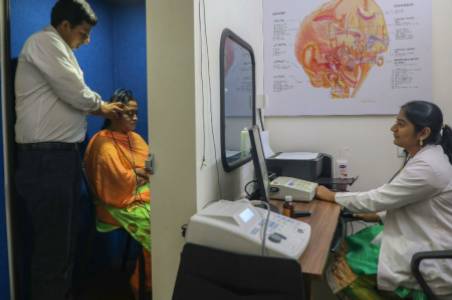Audiometry
Pure tone Audiometry

This is done to evaluate the hearing thresholds & the type of hearing loss. Hearing loss could be due to:
- a problem with sound conduction (conductive loss), or
- a damage to the receptor cells in the inner ear (Cochlea) leading to a condition called Sensori Neural Loss, or
- A combination of the above (Mixed Hearing Loss)
Impedence Audiometry
Impedance is a test which helps to measure compliance (mobility) of the ear drum & pressure in the Middle ear cavity.
Its a valuable tool to make a diagnosis of various middle ear conditions like:
Blockage of the Eustachian tube (the passage connecting the middle ear with the nose)
Fluid in the middle ear
Hearing loss due to a condition called Otosclerosis
Counselling for Ear surgery
Conductive loss is commonly due to defective sound transmission through the Middle ear. Causes include Fluid in the middle ear, Perforation of the Ear drum, damage to the middle ear sound transmission due to infection & fixation of the sound conducting mechanism.
Most of the problems mentioned are amenable to surgical correction/reconstruction.
Tinnitus Evaluation
Tinnitus refers to a ringing sensation in the ear. Tinnitus is a complaint which often accompanies hearing loss. However some patients may have tinnitus without hearing loss.
A subjective tinnitus is perception of sound only by the patient. An objective tinnitus may be heard by a person in close proximity to the patient.
Following a detailed history,
a clinical examination is done to exclude causes which include :
- Wax in the ear canal
- Middle ear conditions
- Hearing loss (conductive or sensorineural)
Treatment of the underlying cause may relieve the Tinnitus. In many patients the cause of tinnitus remains elusive. After a thorough evaluation of the tinnitus, techniques like retraining therapy & use of Tinnitus maskers are used to give relief.
Hearing aid trials & fitting
1. Behind-The-Ear
The Behind-The-Ear (BTE) Style of Hearing Aids are appropriate for people of all ages, being capable of higher amplification of a sound compared to other hearing aid styles. These devices cover loses between Mild to Profound Degree. The device hooks over the top of the ear with a tube that leads to the ear canal, The Tip in the ear canal can be either standardized silicon or a customizable mould.
The new generations of BTE styles are also available with a Rechargeable option and Bluetooth connectivity Smartphones and Televisions.
2. Receiver-In-Canal / Receiver-in-Ear
The Receiver-In-Canal (RIC) / Receiver-in-Ear (RIE) Style of Hearing Aids are the most preferred style and similar to that of a BTE, but the difference is the output of the device (amplified sound waves) is directly fed into the ear canal via a thin wire (speaker). These devices are appropriate for younger adults to geriatric (elderly) population depending on the degree (Mild to Severe Degree) and type of hearing loss.
These devices are also available with a Rechargeable option and Bluetooth connectivity for Smartphones and Televisions. An Alternative style to the RIC is the Slim RIC which are more cosmetically unseen compared to a typical RIC/RIE Style Open fit Hearing Aids
This is a variation of the BTE and RIC/RIE Style of hearing aids. This helps in natural perception of lower frequency sounds and amplification given to the higher frequencies of sound.
3. In –The-Ear / In-The-Canal
The In –The-Ear (ITE) / In-The-Canal (ITC) are customizable hearing aids that are made to fit partly into the ear canal. These devices aid hearing loss between Mild to Moderately Severe degree. The ITE style hearing aids are now also available with a Rechargeable option.
4. Completely-In-Canal
Completely-In-Canal (CIC) are also customizable hearing aids made to fit into the ear canal rendering it completely disclosed. These devices aid hearing loss between Mild to Moderately Severe degree.
5. Invisible-In-Canal
An Alternative option to the Customizable CIC is an Invisible-In-Canal (IIC) style hearing aid, which are customizable and also available as a ready to fit hearing aid for individual with mild to moderate degree of hearing loss rendering it totally invisible in the ear.
